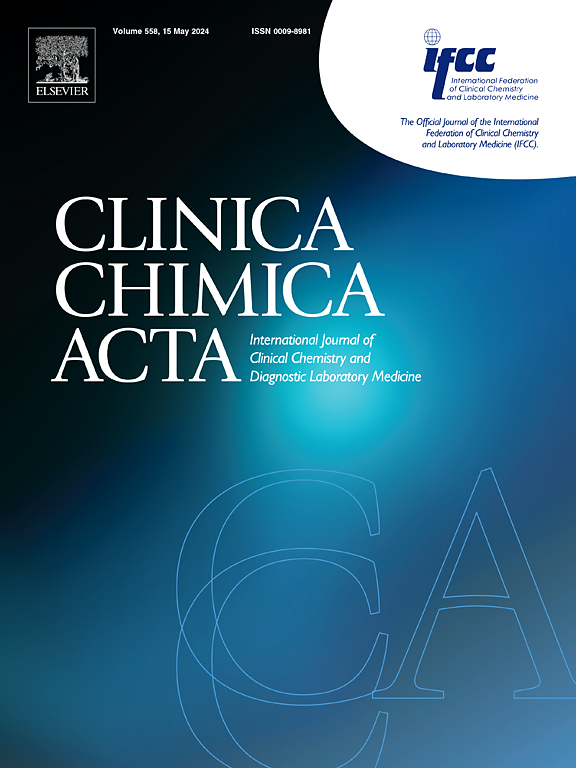血液收集管与蛋白酶抑制剂,以防止假高肾素浓度由于冷冻活化
IF 2.9
3区 医学
Q2 MEDICAL LABORATORY TECHNOLOGY
引用次数: 0
摘要
目的:血浆样品暴露在低温(- 5 ~ + 4℃)下,可使泌乳素转化为开放状态,然后通过血浆蛋白酶将其转化为肾素。这一过程被称为冷冻活化,导致肾素浓度错误升高。本研究考察了储存温度、蛋白酶抑制剂和37℃2小时孵育对肾素冷冻活化的影响。方法采用K2EDTA、抑酶蛋白、胰蛋白酶抑制剂和蛋白酶抑制剂鸡尾酒4种不同类型的试管采集24例患者的血液。在+ 4°C(一周)、- 20°C(两周)和- 80°C(两周)的条件下,在基线和储存后测量肾素浓度(IDS-i10)。在- 20°C下保存的样品随后在37°C下孵育2小时并重新分析。测定醛固酮浓度(LC-MS/MS),计算醛固酮/肾素比(ARR)。结果肾素浓度在- 80°C时保持稳定,在+ 4°C(18 - 50%)和- 20°C(61 - 500%)时显著升高。ARR变化在−80°C时最小(−8 pmol/mU),而在−20°C时最大(−263 pmol/mU)。仅在胰蛋白酶抑制剂和蛋白酶抑制剂鸡尾酒管中37°C孵育2小时后,肾素浓度恢复到基线水平。结论我们的研究表明,与+ 4°C相比,- 20°C保存的血浆中肾素的冷冻活化程度更高。促肾素在胰蛋白酶抑制剂和蛋白酶抑制剂鸡尾酒管中的冷冻活化通过在37°C孵育2小时逆转,这可能是无法在- 80°C冰箱中储存肾素样品的实验室的替代程序。本文章由计算机程序翻译,如有差异,请以英文原文为准。
Blood collection tubes with protease inhibitors to prevent falsely high renin concentrations due to cryoactivation
Objectives
Exposure of plasma samples to low temperatures (between −5 and + 4 °C) leads to conversion of prorenin to its open state, which is then converted to renin by plasma proteases. This process, known as cryoactivation, results in falsely elevated renin concentrations. This study examined the effects of storage temperature, protease inhibitors, and 2-hour incubation at 37 °C on renin cryoactivation.
Methods
Blood samples (n = 24) were collected in four types of tubes: K2EDTA, aprotinin, trypsin inhibitor, and protease inhibitor cocktail. Renin concentrations (IDS-i10) were measured at baseline and after storage at + 4 °C (one week), −20 °C (two weeks), and −80 °C (two weeks). Samples stored at −20 °C were later incubated at 37 °C for two hours and reanalyzed. Aldosterone concentrations were measured (LC-MS/MS) and aldosterone to renin ratios (ARR) were calculated.
Results
Renin concentrations remained stable at −80 °C but increased significantly at + 4 °C (18–50 %) and −20 °C (61–500 %). ARR changes were minimal at −80 °C (−8 pmol/mU) but largest at −20 °C (−263 pmol/mU). Renin concentrations returned to baseline after a 2-hour incubation at 37 °C only in trypsin inhibitor and protease inhibitor cocktail tubes.
Conclusions
Our study shows more cryoactivation of renin in plasma aliquots stored at −20 °C compared to storage at + 4 °C. Cryoactivation of prorenin in trypsin inhibitor and protease inhibitor cocktail tubes was reversed by a 2-hours incubation at 37 °C, which may be an alternative procedure for laboratories that are not able to store renin samples in −80 °C freezers.
求助全文
通过发布文献求助,成功后即可免费获取论文全文。
去求助
来源期刊

Clinica Chimica Acta
医学-医学实验技术
CiteScore
10.10
自引率
2.00%
发文量
1268
审稿时长
23 days
期刊介绍:
The Official Journal of the International Federation of Clinical Chemistry and Laboratory Medicine (IFCC)
Clinica Chimica Acta is a high-quality journal which publishes original Research Communications in the field of clinical chemistry and laboratory medicine, defined as the diagnostic application of chemistry, biochemistry, immunochemistry, biochemical aspects of hematology, toxicology, and molecular biology to the study of human disease in body fluids and cells.
The objective of the journal is to publish novel information leading to a better understanding of biological mechanisms of human diseases, their prevention, diagnosis, and patient management. Reports of an applied clinical character are also welcome. Papers concerned with normal metabolic processes or with constituents of normal cells or body fluids, such as reports of experimental or clinical studies in animals, are only considered when they are clearly and directly relevant to human disease. Evaluation of commercial products have a low priority for publication, unless they are novel or represent a technological breakthrough. Studies dealing with effects of drugs and natural products and studies dealing with the redox status in various diseases are not within the journal''s scope. Development and evaluation of novel analytical methodologies where applicable to diagnostic clinical chemistry and laboratory medicine, including point-of-care testing, and topics on laboratory management and informatics will also be considered. Studies focused on emerging diagnostic technologies and (big) data analysis procedures including digitalization, mobile Health, and artificial Intelligence applied to Laboratory Medicine are also of interest.
 求助内容:
求助内容: 应助结果提醒方式:
应助结果提醒方式:


